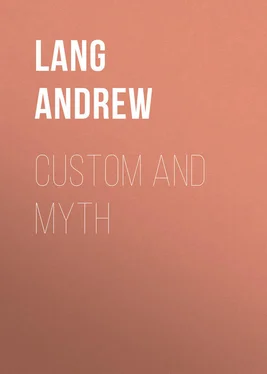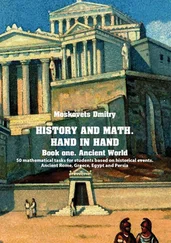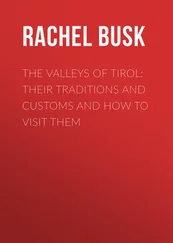Andrew Lang - Custom and Myth
Здесь есть возможность читать онлайн «Andrew Lang - Custom and Myth» — ознакомительный отрывок электронной книги совершенно бесплатно, а после прочтения отрывка купить полную версию. В некоторых случаях можно слушать аудио, скачать через торрент в формате fb2 и присутствует краткое содержание. Жанр: foreign_antique, foreign_prose, на английском языке. Описание произведения, (предисловие) а так же отзывы посетителей доступны на портале библиотеки ЛибКат.
- Название:Custom and Myth
- Автор:
- Жанр:
- Год:неизвестен
- ISBN:нет данных
- Рейтинг книги:3 / 5. Голосов: 1
-
Избранное:Добавить в избранное
- Отзывы:
-
Ваша оценка:
- 60
- 1
- 2
- 3
- 4
- 5
Custom and Myth: краткое содержание, описание и аннотация
Предлагаем к чтению аннотацию, описание, краткое содержание или предисловие (зависит от того, что написал сам автор книги «Custom and Myth»). Если вы не нашли необходимую информацию о книге — напишите в комментариях, мы постараемся отыскать её.
Custom and Myth — читать онлайн ознакомительный отрывок
Ниже представлен текст книги, разбитый по страницам. Система сохранения места последней прочитанной страницы, позволяет с удобством читать онлайн бесплатно книгу «Custom and Myth», без необходимости каждый раз заново искать на чём Вы остановились. Поставьте закладку, и сможете в любой момент перейти на страницу, на которой закончили чтение.
Интервал:
Закладка:
1
Compare De Cara: Essame Critico , xx. i.
2
Revue de l’Hist. des Rel . ii. 136.
3
Sprachvergleichung und Urgeschichte , p. 431.
4
Prim. Cult . i. 394.
5
A study of the contemporary stone age in Scotland will be found in Mitchell’s Past and Present.
6
About twenty years ago, the widow of an Irish farmer, in Derry, killed her deceased husband’s horse. When remonstrated with by her landlord, she said, ‘Would you have my man go about on foot in the next world?’ She was quite in the savage intellectual stage.
7
At the solemn festival suppers, ordained for the honour of the gods, they forget not to serve up certain dishes of young whelp’s flesh. (Pliny, H. N . xxix. 4.)
8
Nov. 1880.
9
‘Ah, once again may I plant the great fan on her corn-heap, while she stands smiling by, Demeter of the threshing floor, with sheaves and poppies in her hands’ (Theocritus, vii. 155-157).
10
Odyssey , xi. 32.
11
Rev. de l’Hist. des Rel ., vol. ii.
12
Pausanias, iii. 15. When the boys were being cruelly scourged, the priestess of Artemis Orthia held an ancient barbaric wooden image of the goddess in her hands. If the boys were spared, the image grew heavy; the more they were tortured, the lighter grew the image. In Samoa the image (shark’s teeth) of the god Taema is consulted before battle. ‘If it felt heavy, that was a bad omen; if light, the sign was good’ – the god was pleased (Turner’s Samoa , p. 55).
13
Kamilaroi and Kurnai , p. 268.
14
Fison, Journal Anthrop. Soc ., Nov. 1883.
15
Taylor’s New Zealand , p. 181.
16
This is not the view of le Père Lafitau, a learned Jesuit missionary in North America, who wrote (1724) a work on savage manners, compared with the manners of heathen antiquity. Lafitau, who was greatly struck with the resemblances between Greek and Iroquois or Carib initiations, takes Servius’s other explanation of the mystica vannus , ‘an osier vessel containing rural offerings of first fruits.’ This exactly answers, says Lafitau, to the Carib Matoutou , on which they offer sacred cassava cakes.
17
The Century Magazine, May 1883.
18
Κωνος ξυλαριον ου εξηπται το σπαρτιον και εν ταις τελεταις εδονειτο ινα ροιζη. Lobeck, Aglaophamus (i. p. 700).
19
De Corona , p. 313.
20
Savage Africa . Captain Smith, the lover of Pocahontas, mentions the custom in his work on Virginia, pp. 245-248.
21
Brough Smyth, i. 60, using evidence of Howitt, Taplin, Thomas, and Wilhelmi.
22
Kamilaroi and Kurnai, p. 214.
23
Περι ορχησεως, c. 15.
24
Cape Monthly Magazine, July 1874.
25
Wallace, Travels on the Amazon , p. 349.
26
New Zealand , Taylor, pp. 119-121. Die heilige Sage der Polynesier , Bastian, pp. 36-39.
27
A crowd of similar myths, in one of which a serpent severs Heaven and Earth, are printed in Turner’s Samoa.
28
The translation used is Jowett’s.
29
Theog ., 166.
30
Apollodorus, i. 15.
31
Primitive Culture , i. 325.
32
Pauthier, Livres sacrés de l’Orient , p. 19.
33
Muir’s Sanskrit Texts , v. 23. Aitareya Brahmana.
34
Hesiod, Theog ., 497.
35
Paus. x. 24.
36
Bleek, Bushman Folklore , pp. 6-8.
37
Theal, Kaffir Folklore , pp. 161-167.
38
Brough Smith, i. 432-433.
39
i. 338.
40
Rel. de la Nouvelle-France (1636), p. 114.
41
Codrington, in Journal Anthrop. Inst . Feb. 1881. There is a Breton Märchen of a land where people had to ‘bring the Dawn’ daily with carts and horses. A boy, whose sole property was a cock, sold it to the people of this country for a large sum, and now the cock brings the dawn, with a great saving of trouble and expense. The Märchen is a survival of the state of mind of the Solomon Islanders.
42
Selected Essays , i. 460.
43
Ibid . i. 311.
44
Ueber Entwicklungsstufen der Mythenbildung (1874), p. 148.
45
ii. 127.
46
G. D. M ., ii. 127, 129.
47
Gr. My ., i. 144.
48
De Abst ., ii. 202, 197.
49
Rel. und Myth ., ii. 3.
50
Ursprung der Myth ., pp. 133, 135, 139, 149.
51
Contemporary Review , Sept. 1883.
52
Rev. de l’Hist. rel . i. 179.
53
That Pururavas is regarded as a mortal man, in relations with some sort of spiritual mistress, appears from the poem itself (v. 8, 9, 18). The human character of Pururavas also appears in R. V. i. 31, 4.
54
Selected Essays , i. 408.
55
The Apsaras is an ideally beautiful fairy woman, something ‘between the high gods and the lower grotesque beings,’ with ‘lotus eyes’ and other agreeable characteristics. A list of Apsaras known by name is given in Meyer’s Gandharven-Kentauren , p. 28. They are often regarded as cloud-maidens by mythologists.
56
Selected Essays , i. p. 405.
57
Cf. ruber , rufus , O. H. G. rôt , rudhira , ερυθρος ; also Sanskrit, ravi , sun.
58
Myth. Ar. Nat ., ii. 81.
59
R. V. iii. 29, 3.
60
The passage alluded to in Homer does not mean that dawn ‘ends’ the day, but ‘when the fair-tressed Dawn brought the full light of the third day’ ( Od ., v. 390).
61
Liebrecht ( Zur Volkskunde , 241) is reminded by Pururavas (in Roth’s sense of der Brüller ) of loud-thundering Zeus, εριyδουπος.
62
Herabkunft des Fetters , p. 86-89.
63
Liebrecht ( Zur Volkskunde , p. 241) notices the reference to the ‘custom of women.’ But he thinks the clause a mere makeshift, introduced late to account for a prohibition of which the real meaning had been forgotten. The improbability of this view is indicated by the frequency of similar prohibitions in actual custom.
Читать дальшеИнтервал:
Закладка:
Похожие книги на «Custom and Myth»
Представляем Вашему вниманию похожие книги на «Custom and Myth» списком для выбора. Мы отобрали схожую по названию и смыслу литературу в надежде предоставить читателям больше вариантов отыскать новые, интересные, ещё непрочитанные произведения.
Обсуждение, отзывы о книге «Custom and Myth» и просто собственные мнения читателей. Оставьте ваши комментарии, напишите, что Вы думаете о произведении, его смысле или главных героях. Укажите что конкретно понравилось, а что нет, и почему Вы так считаете.












